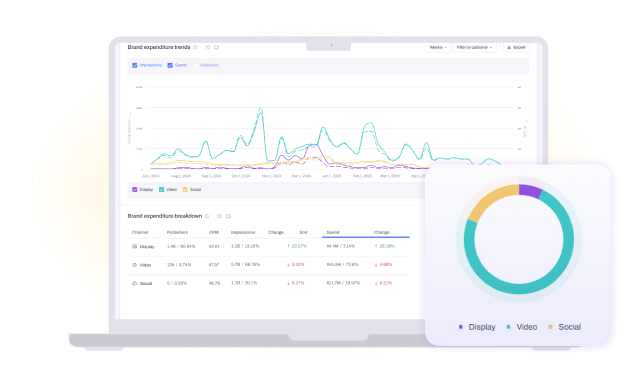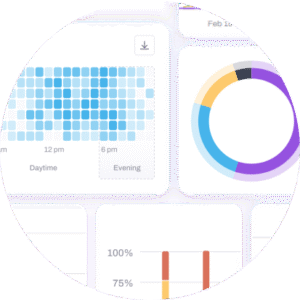The Largest Ad Inventory in the World
Driven by tens of millions of page views every day, AdClarity brings the largest and most
comprehensive ad intelligence coverage in the world, tracking over 1 million brands daily
Home
Monitor competitors and market leaders across channels
Spot trends and benchmark performance in your industry
See clear, actionable insights instantly
Create reports that fit every audience
The difference is clear: smarter decisions, stronger results.
KPIs reported in isolation
Budget requests lack market proof
Reactive optimization
Missed opportunities in media mix









Show strategy alignment with market trends. Defend spend. Secure growth budgets.

Uncover underperforming channels and outperform competitors with data-backed shifts.

Build smarter, market-aligned media strategies and report impact with clarity.
Show how your campaigns stack up. Get real market context and win budget with clarity.
Campaign metrics alone aren’t enough. Internal KPIs show how you’re performing, but they can’t answer:
When it’s time to report to leadership or secure budget, assumptions won’t cut it. You need the full picture.

AdClarity tracks digital advertising across web, mobile, video, social, and CTV – at scale. It continuously collects and organizes real-time data on:
All delivered in an intuitive dashboard that makes it easy to analyze, share, and act.
Discover how AdClarity can revolutionize your marketing strategies with its advanced insights and powerful tools. Schedule a demo today and see firsthand how our platform delivers unmatched value for your business.
436B+ ad impressions analyzed per month – global data at your fingertips.
Trusted by top brands, agencies, publishers and research firms to drive marketing success.
Daily updates and real-time access –
stay ahead of the competition
at all times
“AdClarity helps me uncover examples of B2B ads in my industry, providing clear insights into their messaging and design concepts. My team and I use this to improve campaigns and follow industry best practices.”

Alison Langford
Global Digital Marketing Lead, JMP
“We really like AdClarity. It’s a great tool for discovering what competitors and other industry players are doing, helping us revamp and improve our marketing strategies.”

Andrea Schettino
Product Manager, Mastercard
“AdClarity has been a valuable tool for years. It helps us create detailed competitive ad spend reports, which guide client budget recommendations and support a profitable service offering.”


Brenda Young
Vice President, Convergence Point Media
“AdClarity is a valuable tool for gaining competitive insights and understanding the media mix of key players. It helps us identify new opportunities and fine-tune strategies with real, actionable data. The platform is intuitive and offers a clear view of the digital landscape.”


Dana Faierman
BizOps Manager, Mani-festo by Intango
“AdClarity provides quick access to competitor campaigns and brand growth insights. Its multi-currency feature allows viewing cost estimates in preferred currencies—very convenient! It also helps me identify the best mobile apps for ad placements, boosting visibility.”


Shaitsha Farheen
Senior Consultant, Deloitte
“AdClarity is a great tool that enables us to explore the wide eco-system of online advertising. The tool is very friendly and gives us quick and clear visibility into existing and new opportunities”


Alex Selly
Head of Marketing, Adidas AG Europe
“AdClarity is a great tool for anyone active in the advertising space. It provides my company easy access to relevant campaigns, landing pages and other promotional data all contained on one platform with very knowledgeable support staff at hand.”


Jennifer Bartton
Marketing Manager, Wix
“AdClarity gave us such incredible results! It really made display a feasible investment and revolutionized the way we do digital advertising”

Ying Su
Business Development Manager, Boku
Driven by tens of millions of page views every day, AdClarity brings the largest and most
comprehensive ad intelligence coverage in the world, tracking over 1 million brands daily








A benchmark is a reference number – often an average or percentile – for metrics like spend, CPM or conversion rate, used to judge whether your campaign over – or under-performs the market.
They show how efficiently you reach and convert audiences compared with similar brands, turning raw results into context that clients or executives can trust.
Divide campaign profit by cost, then compare the ratio to peer averages; a higher return signals efficient spending, while lower ROI suggests optimisation is needed.
Common metrics include impressions, reach, CPM, CPC, CPA, conversion rate, share-of-voice and total spend across channels.
Refresh digital metrics weekly or monthly; review strategic indicators like annual share-of-voice at least quarterly to keep comparisons accurate.
Choose brands with similar industry, audience size, geography and media budget; excluding giants or niche players prevents skewed averages.
Comparing your Google Ads CPA to the median CPA of five direct competitors to decide if bid adjustments or creative changes are needed.
“Good” depends on industry and funnel stage; use peer medians and top-quartile figures to define realistic targets instead of a single universal number.
Incomplete channel data, seasonality spikes, last-click bias and different attribution windows can mislead; normalise periods and validate with first-party analytics.
Fill in your details to receive a FREE live ad analysis of your top 3 competitors